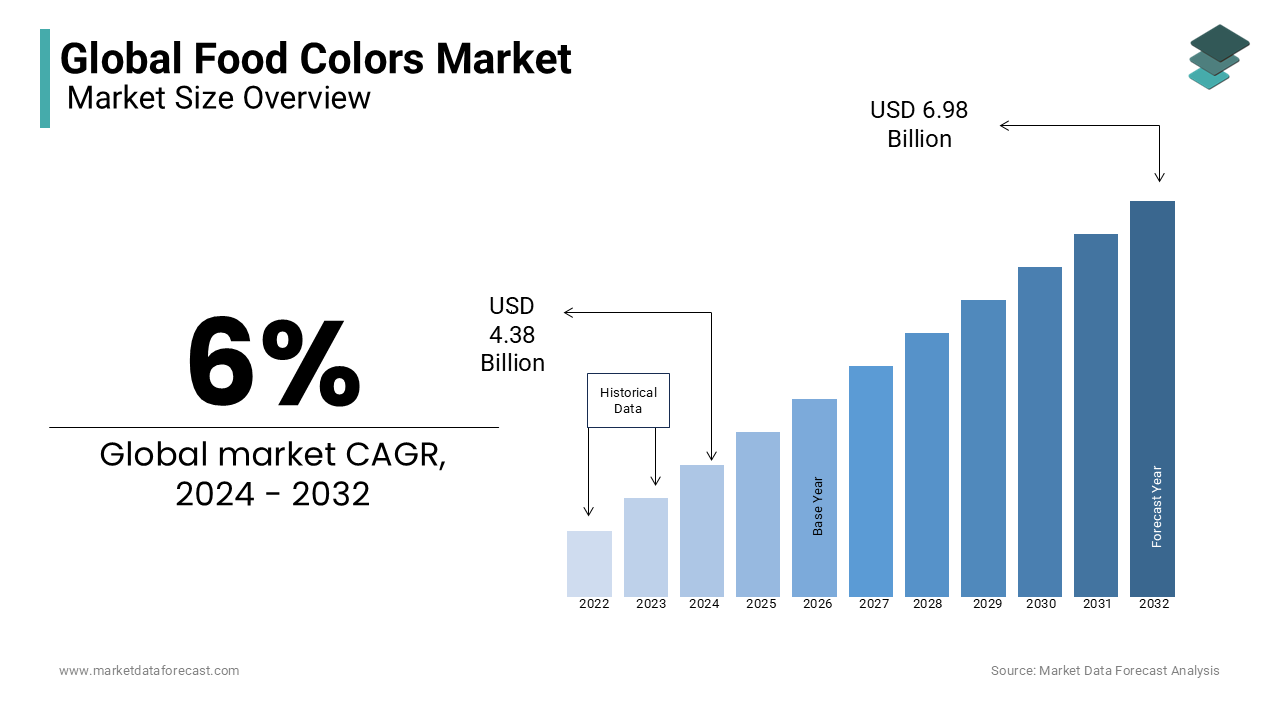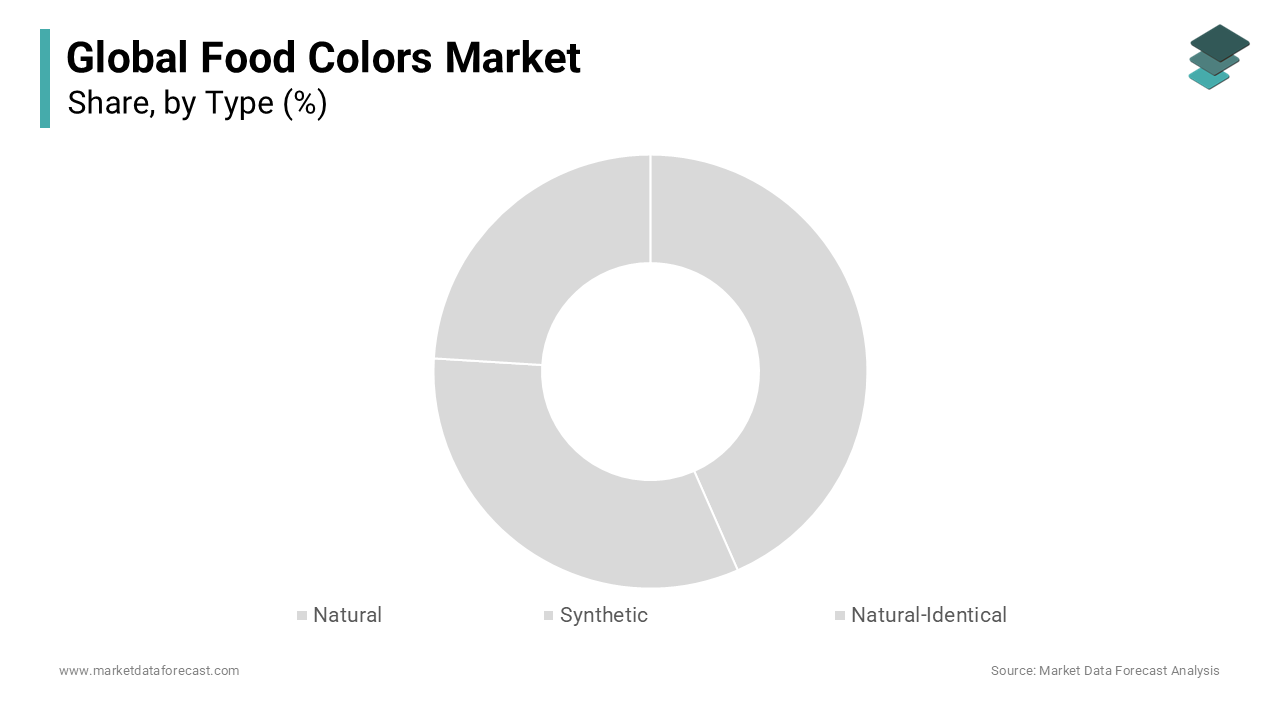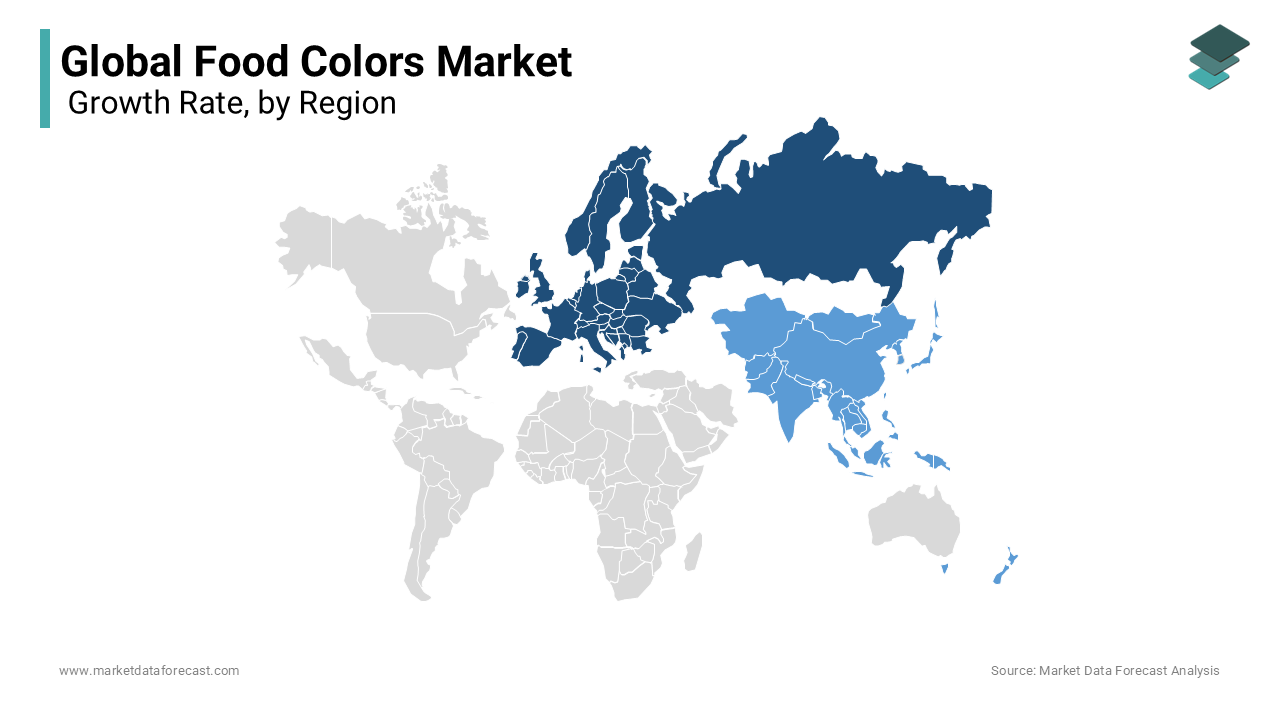Global Food Colors Market Size, Share, Trends & Growth Forecast Report - Segmented By Type (Natural, Synthetic, Natural-Identical), Application (Beverages, Processed Food, Bakery & Confectionery Products, Oils & Fats, Dairy Products, Meat, Poultry, Seafood), Form (Gel, Powder, Liquid, Paste), And Region(North America, Europe, Asia-Pacific, Latin America, Middle East And Africa) - Global Industry Analysis, Size, Share, Growth, Trends And Forecast 2025 To 2033
Global Food Colors Market Size
The size of the global food colors market was expected to be worth USD 4.38 billion in 2024 and is anticipated to be worth USD 7.40 billion by 2033 from USD 4.64 billion In 2025, growing at a CAGR of 6% during the forecast period.

Food colors improve the presence of processed and crisp food. They are widely utilized in pharmaceutical, candy store, bakery, packaged food sources, confectionery, refreshments, beautifying agents, and others. The significance of food colors has expanded in the past few decades with the approach of present-day food processing techniques, the smallest advance of which crushes the natural coloring in food. Adding back what is lost during preparation is named as 'food enhancement'. Be that as it may, this value-added expansion is satisfied by food added substances.
Food colors establish a significant piece of food added substances. The previous 10-15 years have witnessed a particular shift toward natural materials, particularly inside flavors and colors. Expanding request and purchaser inclination for negligibly processed foods and wellbeing advancing properties of natural colors are relied upon to drive the global food colors market, twice as quick as the synthetic market.
Expanding Demand For Natural Food Colors. There has been considerable demand in the advancement of new standard colors utilized in the food business, which is because of substantial purchaser interest for progressively natural items, universally. The wellbeing upgrading properties of natural colors, joined with the natural features in the everyday objects, is likewise expanding the intrigue for the equivalent. Limitations in food colors are essential because of the higher production cost of fermentation colors, contrasted with shades of the synthetic cause or separated from the natural source. FDA utilizes the term 'exempt color additives' to demonstrate that they are absolved from the accreditation procedure.
MARKET DRIVERS
The size of the global food colors market is developing exponentially because of elements like better discernment by customers of safe items for food colors.
The propensity to advance wellbeing by the use of natural food colors is additionally a component boosting the worldwide food colors market. With the expanding globalization, the food business has been enhanced as it were.
Different cooking styles all over the world are currently effectively available to clients, changing their food utilization propensities. This adjustment in shopper diet designs gave a fantastic lift to the extension of the worldwide food colors industry. Besides, the ascent in discretionary cash flow and fast development of speedy assistance eateries over the globe are likewise going about as an impetus for this market blast.
With the increasing globalization, people around the world prefer different cuisines with intense flavors and aesthetic appeal. This has offered a massive push to the makers of food colors to develop and introduce innovative products to increase their customer base. The increase in the promotion of the products through different mediums and the organized retail sector are also driving the business growth in this industry. The online trade is another improvement in the global food colors market, which is foreseen to expand in a significant way in the anticipated period.
MARKET RESTRAINTS
Then again, a couple of perspectives are hindering the extension of the global foods colors market.
High beginning establishment cost and medical issues made by the utilization of synthetic colors are, for the most part, engaged ones among those hindrances. The strict government regulations in the manufacturing of various food colors are also acting as an impediment to the expansion of this sector across the globe.
REPORT COVERAGE
|
REPORT METRIC |
DETAILS |
|
Market Size Available |
2024 to 2033 |
|
Base Year |
2024 |
|
Forecast Period |
2025 to 2033 |
|
CAGR |
6% |
|
Segments Covered |
By Type, Application, Form, and Region |
|
Various Analyses Covered |
Global, Regional & Country Level Analysis; Segment-Level Analysis, DROC, PESTLE Analysis, Porter’s Five Forces Analysis, Competitive Landscape, Analyst Overview of Investment Opportunities |
|
Regions Covered |
North America, Europe, APAC, Latin America, Middle East & Africa |
|
Market Leaders Profiled |
Chr. Hansen S/A, Sensient Technology Corporation, Archer Daniels Midland Company, MC Corporation, Koninklijke DSM N.V, D.D. Williamson & Co. Inc, Fiorio Colori, Naturex S.A, Döhler Group, Kalsec Inc and Others |
SEGMENTAL ANALYSIS
Global Food Colors Market Analysis By Type

The natural segment is attributed to holding the dominant share of the market. Customer’s choices for clean-label ingredients and organic food products to be safe from various high-risk diseases are majorly driving the growth rate of the food colors market. A rising number of companies are introducing various flavored products specifically made up of clean-label ingredients without using any artificial items, which subsequently boosts the growth rate of the market.
The natural-identical segment is likely to have a prominent growth rate during the forecast period. To launch food products at affordable prices and with naturally identical ingredients that do not pose harmful effects is likely to gear up the market’s growth rate. The growing demand to fulfill the demand with the increasing population, especially in urban cities with varied food supply chains, is esteemed to promote the growth rate of the market.
Global Food Colors Market Analysis By Application
The dairy products segment is likely to have a significant share of the food coloring market. The prominent consumers of dairy products, due to their effective nutritional value, which is highly required to lead quality lifestyles in today’s world, are augmented in gearing up the growth rate of this segment. The government's strong initiative to prioritize high-quality dairy products is another factor that enhances the growth rate of the market. Growing awareness towards naturally manufactured dairy products among the public through social media influencers is additionally leveraging the growth opportunities for this segment.
The beverages segment is next in holding a prominent share of the food colors market. Many companies focus on launching different flavored beverages in accordance with the customer’s choices. The strategies to launch new products, especially by using food colors, are augmented to propel the growth rate of the market.
Global Food Colors Market Analysis By Form
Powder has held a significant share of the market for the past few years and is attributed to continuing the same growth rate during the forecast period. This is convenient to use according to the food type and poses excellent color and texture. The use of powder food color will be dependent on the application, which signifies its color and taste. In recent eras, some food colors have been launched by simply using natural ingredients where that can be used in various recipes.
The liquid form is likely to have the highest CAGR by the end of the forecast period. This form is mostly made of synthetic coloring using traditional methods that are widely used in many restaurants and food vendors. These are available in a watery state, to which additional color can be added according to the base of the requirement.
REGIONAL ANALYSIS

Europe dominated the overall food colors market. In the European Union, food colors are controlled as food added substances, under an exhaustive arrangement of guidelines, for food improvement specialists. By and by, in the European Union, 39 colors are approved as color additives, for utilization in foods. European food colors market keeps on catching the most significant piece of the pie, because of the developing interest for clean labels foods and wellbeing mindfulness. In the United Kingdom, the rising sanitation concerns are pressurizing assemblies to receive clean labels, which are set off the interest for natural colors. In France, key players like Naturex, are chipping away at the improvement of 100% natural concentrate adaptation of curcumin, to give a rainbow of yellow coloring, to a scope of culinary applications, from sauces and snacks to desserts, frozen yoghurts and processed products.
The Asia Pacific food colors market is anticipated to encounter the most noteworthy development in the coming years because of components, for example, high production levels in nations such as New Zealand and Australia, populace development, expanding interest for standard items and the advancement of a way of life and broadened customer spending on food and drinks within the area. The development of this locale is animated by the food business in Japan, India, and China, and by the significant increment in exchange food coloring results of these nations. North America and South America are additionally some critical areas in the worldwide food colors market.
KEY PLAYERS IN THE GLOBAL FOOD COLORS MARKET
Major Key Players in the Global Food Colors Market are Chr. Hansen S/A, Sensient Technology Corporation, Archer Daniels Midland Company, MC Corporation, Koninklijke DSM N.V, D.D. Williamson & Co. Inc, Fiorio Colori, Naturex S.A, Döhler Group, Kalsec Inc and Others
RECENT HAPPENINGS IN THE MARKET
- Sensient Technologies has propelled three new food colors: natural dark carrot, natural duck and natural beet. With this dispatch, the organization has extended its arrangement of natural food colorants.
- WILD Flavors and Specialty Ingredients, a business segment of ADM, has extended its arrangement of natural food colors by including food colors based pumpkin separates and a one of a kind assortment of carrots containing lycopene.
- ADM began an advancement place in Singapore to help R&D exercises in the Asia-Pacific district.
- Chr. Hansen extended its standard food coloring division to North America by procuring an assembling office for Banker Wire (United States).
- Sensient Technologies acquired GlobeNatural (Peru), and the acquired company is now called as Sensient Natural Colors Peru S.A.C. (Peru).
DETAILED SEGMENTATION OF GLOBAL FOOD COLORS MARKET INCLUDED IN THIS REPORT
This research report on the global food colors market has been segmented and sub-segmented based on type, application, form, & region.
By Type
- Natural
- Synthetic
- Natural-Identical
By Application
- Beverages
- Processed Food
- Bakery & Confectionery Products
- Oils & Fats
- Dairy Products
- Meat
- Poultry
- Seafood
By Form
- Gel
- Powder
- Liquid
- Paste
By Region
- North America
- Europe
- Asia-Pacific
- South America
- Middle East & Africa
Frequently Asked Questions
1. What are the major challenges facing the food colors market?
Challenges include the higher cost of natural colors compared to synthetic dyes, stability issues with natural colors, and stringent regulatory requirements.
2. What are the main drivers of growth in the food colors market?
Key drivers include the rising demand for natural and clean-label products, growing consumer awareness of health and wellness, the expanding food and beverage industry, and technological advancements in food color production.
3. What opportunities exist for new entrants in the food colors market?
Opportunities lie in the development of cost-effective and stable natural color solutions, innovations in plant-based and functional foods, and expanding into emerging markets with growing food processing industries.
Related Reports
Access the study in MULTIPLE FORMATS
Purchase options starting from $ 2500
Didn’t find what you’re looking for?
TALK TO OUR ANALYST TEAM
Need something within your budget?
NO WORRIES! WE GOT YOU COVERED!
Call us on: +1 888 702 9696 (U.S Toll Free)
Write to us: [email protected]